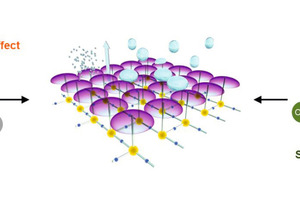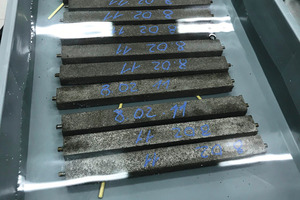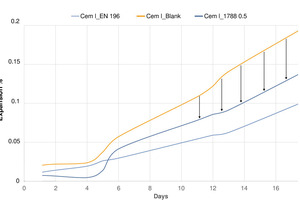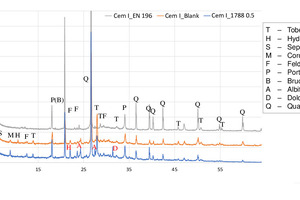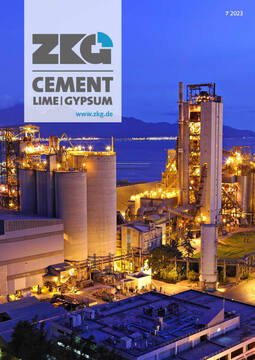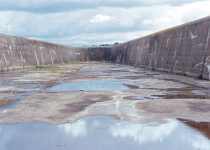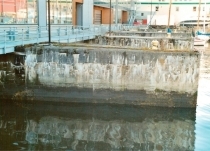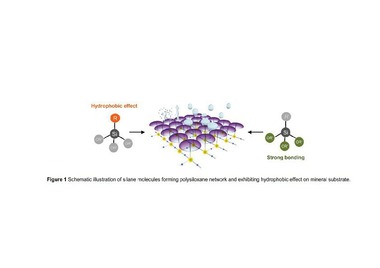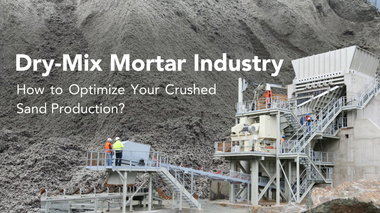Concrete: silicone-based additive inhibits alkali-aggregate reactions
Suitable sand and aggregate types for concrete have become increasingly scarce in most regions. Switching to poorer qualities bears the risk of long-term effects on the stability and durability of concrete. One of the issues is that some sands and aggregates show an active expansion when interacting with the alkali content of cement. As a result, the concrete structure starts to form cracks and collapses long before the end of its usual life cycle. A new silicone-based additive helps to suppress this effect. It inhibits alkali aggregate reactions, even when using “out-of spec” aggregates.
Introduction
Sand scarcity in the construction industry is a worldwide problem [1, 2, 3, 4, 5]. Owing to the scarcity of suitable sand and aggregates, the industry is increasingly turning to materials that may bear the risk of impairing the durability and longevity of concrete. One of the major risks involved is the so-called Alkali Aggregate Reaction (AAR). AAR causes a significant weakening of concrete from inside which leads to sudden failure of structures under load or serious cracks, resulting in critical structural problems that can even force the demolition of a particular structure [9, 10].
Alkali-aggregate reaction is likely to be a result of two processes that take place either separately or at the same time [16]. The first of them is Alkali-Silica Reaction (ASR). If amorphous silicates interact with alkali metal ions present in cementitious mixtures, the solid amorphous rock slowly dissolves, forming a gel that swells as it adsorbs water from the surrounding environment. This process can induce excessive internal stress to form cracks [8, 9].
The second process is Alkali-Carbonate Reaction (ACR). It is a result of the interaction between alkali ions from a cement with magnesium carbonate, which dissolves slowly and forms the crystalline product Mg(OH)2. Mg(OH)2 has a larger volume in comparison to its initial components. This leads to an increase of internal stress and the formation of cracks from inside, which demolishes the structure of the entire concrete [10, 16].
Preventive measures to inhibit alkali aggregate reactions
One of the approaches to prevent this harmful process is to restrict water from interacting with ions in ASR/ACR reagents. Hydrophobation with silane-siloxane-based chemicals have been used to protect cementitious building materials against moisture and consequential deteriorations for decades [11, 12].
Reactive siloxy-groups in alkali environments preferably interact with OH- groups of the mineral substrate resulting in the formation of -Si-O-Si- bonds (Figure 1). The same bonds appear between closely nested neighboring organosilane-siloxane-groups as a result of hydrolyses and condensation processes. Consequently, the polysiloxane net which covers the entire concrete pore system leads to a greatly enhanced structural durability.
The siloxane-silane network is linked to the substrate with the alkyl-groups turned to the outer surface. They act as a chemical “umbrella”. This prevents water with its ions from penetrating the substrate from the outside while allowing single water molecules to evaporate from the surface (Figure 1, center). Such a protective layer significantly reduces the risk of AAR in pores and voids due to reduction of metal ion penetration.
The other option to reduce AAR is using lith-ium salts. Such an approach has been successfully used for more than 50 years to solely prevent alkali silica reaction (ASR). Li+ ions interact with the ASR product and transform the amorphous swelling “sponge” into crystalline products with smaller volumes [6]. Ultimately, lithium-ions show no effect on the alkali-carbonate reaction [7]. Considering the increasing demand in the battery industry, it is fair to assume that lithium will not be a viable option for the concrete industry in future.
In a scientific study conducted in 2021, Wacker showed that silane-siloxane substances are able to suppress Alkali-Silica Reactions efficiently [13]. In this paper, the findings of the most recent investigation on a new silane-siloxane microemulsion called SILRES® BS 1788 will be presented and how its chemistry can successfully inhibit Alkali Aggregate Reactions in cementitious structures.
Test procedure
The protective effect of the self-emulsified silane-siloxane product Silres BS 1788 in concrete was demonstrated with an accelerated test procedure in accordance to ASTM C1260. This method permits the detection of a potential risk for deleterious alkali-silica and alkali-carbonate reactions in mortar bars. The procedure is especially useful for aggregates that react slowly or expand late during the reaction.
The test was conducted with mortar bars formulated with two different types of sand: one sand was produced according to EN 196-1 and showed no alkali silica reaction at all (“in-spec sand”). The other sample was provided by a concrete producer who intended to use the material in a project. It consisted of a combination of Na-K feldspar, albite, clays, dolomite and calcite in different forms. It was therefore classified as high risk material in terms of ASR, as feldspars and dolomite are known to lead to the expansion of mortar or concrete specimens [14, 6]. The cement used for the mortar bars was CEM I 42.5 N, according to EN 197-1.
The cement was mixed with water, before adding either the in-spec or the out-of-spec sand. The mortar was then filled into molds to form prisms of the size 25 x 25 x 258 mm. After hardening, the mortar bars were exposed to 1 mol per liter sodium hydroxide (1M NaOH). All prisms were completely immersed in the solution for 14 days at 80 °C (Figure 2). Dimension changes were checked and measured on a regular basis.
Results
The results of the test are presented in Figure 3. The graphs show that the expansion of the bars formulated with the AAR-inactive sand was lower than 0.1% after 14 days (light blue graph “Cem I_EN 196”), while the prisms containing the reactive sand showed 0.2% expansion (orange graph “Cem I_Blank). The dark blue graph “Cem I_1788 0.5” denotes the sample which contained Silres BS 1788. It clearly shows significantly reduced expansion, when compared to the orange graph. This improvement, illustrated with vertical arrows in Figure 3, makes the sand “applicable in construction” in accordance with ASTM C1778.
Analytical results
The mortar samples were exposed to the 1M NaOH solution for 14 days at 80 °C. Then, the prisms were crushed and ground in a ball mill, resulting in a uniform powder which made sure that the test results were representative. Finally, the prisms and their crystalline structure were analyzed by X-ray diffraction (XRD), a commonly used analytical technique in the cement industry to identify crystalline structures (Figure 4).
The XRD graphs were interpreted with the help of the following three data bases: International Center for Diffraction Data (ICDD), Crystallography Open Data (COD), and Joint Committee on Chemical Analysis by Powder Diffraction Methods (JCPDS).
A summary of the phase composition can be seen in Table 1: Ca(OH)2 or portlandite, together with SiO2 or quartz were present in all of the samples. This is not a surprise as these are typical products in cement pastes after curing. Brucite was also found which indicates that Mg(OH)2 had formed as a result of Alkali Carbonate Reaction [14, 6] in the Cem I_Blank sample. The presence of a mixed Na+/Ca2+ albite phase is a result of the partial substitution of sodium-ions with calcium-ions in the crystal structure of a normal Na+-albite phase. This process is believed to be responsible for the expansion of the mortar bars as described by En-Hua Yang et al. in “Effect of calcium hydroxide on the alkali-silica reaction of alkali-activated slag mortars activated by sodium hydroxide”, Construction and Building Materials 272 (2021) 121868 [15].
Finally, the sample with the reactive sand and Silres BS 1788 were analysed, which consisted of quartz, portlandite, Na+ albite, and dolomite. According to Tetsuya Katayama [16], ASR and ACR can be found together in natural fillers. According to the XRD analysis, however, no penetration of Ca2+ into Na+albite structure and no Ca2+/Mg2+ immigration from the surface to the pore structures occurred. In other words, it was not possible to detect any ASR and ACR related products in this case, only reagents for these reactions. The presence of dolomite, as the main reagent for ACR, and the absence of brucite, a product of ACR, proves that no alkali-carbonate induced reaction occurred in the sample, which consisted of reactive sand, but had been treated with Silres BS 1788.
The analysis of the crystal structure also shed some light on how silane-siloxane chemistry possibly prevents ACR and ASR. It seems that the polycondensed network that covers the pores of the mortar bars prevents an exchange of ions: Ca2+ does not interact with albite, and magnesium carbonate does not transform into hydroxide. So, it can be said that the capillary structure most likely became inert or was inactivated during the curing process.
Based on the results of the ASTM 1260 investigation and the X-ray diffraction analysis, it can be concluded that the use of “out-of-spec” sand with some impurities can still be used for construction purposes, if the mortar is treated with a silicone additive that “passivates” the mortar and holds ions outside of the mineral components, preventing harmful expansive reactions within the structure.
Conclusion
The investigation revealed a unique property of silane-siloxanes. The test results in accordance with ASTM C1260 show that sand which falls short of standard construction requirements, can be made suitable for construction purposes in accordance with ASTM C1260 and ASTM C1778 with Silres BS 1788. Adding 0.5% of the product is sufficient to make the cement compliant to the guidelines.
Although the exact mechanism is not clear yet, the XRD results show that the silicon-based network apparently reduces the ion exchange between the pores of the structure and the mineral matrix, which minimizes the occurrence of both alkali-silica and alkali-carbonate reactions significantly.

